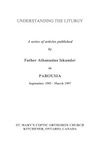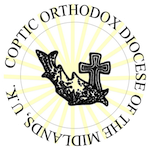
Understanding the Liturgy: Mercy, Peace, the Sacrifice of Praise
“Offer in order, stand in trembling, look towards the East.” With this exhortation the deacon signalled the people (in older times) to bring forward their offerings to the altar. But now things have changed, the offering of the bread and wine has been moved to the beginning of the Liturgy, and the deacons, rather than the congregation, bring it to the Sanctuary. So, why did the Church keep that exhortation to the people to offer?
To answer this we have to understand the meaning of offering in the early Church. Indeed, the basic Eucharistic offering was the bread and wine, but that was not all. Father Schmemman explains this.
In the experience and in the practice of the early Church, the Eucharistic sacrifice was offered not only on behalf of all and for all, but by all, and therefore the real offering by each of his own gift, his own sacrifice, was a basic condition of it. Each person who came into the gathering of the Church brought with him everything that “as he has made up his mind” (2Cor. 9:7), he could spare for the needs of the Church, and this meant for the sustenance of the clergy, widows and orphans, for helping the poor, for all the good works in which the Church realizes herself as the love of Christ, as concern for all and service of all to all. The Eucharistic offering is rooted precisely in this sacrifice of love, therein lies its origin. And this was so self evident for the Church that, according to one witness, orphans who lived at the expense of the Church and did not have anything to bring participated in this sacrifice of love by bringing water. [37]
We find confirmation to Father Schmemman’s words in our own liturgical tradition. One of the oldest prayers of the Liturgy is called the “Prayer for the Offerings”. This prayer which belongs to the liturgy of St. Mark, is also said during the morning offering of incense on Sundays. In this prayer the priest says, “Remember O Lord, the sacrifices, the offerings (prosphora) and the thanksgiving of those who have offered, unto the honour and the glory of thine holy name.” The deacon would then respond,
Pray for those who have care for the sacrifices, the offerings, firstfruits, oil, incense, veils, reading books, and altar vessels, that Christ our God reward them in the heavenly Jerusalem and forgive us our sins.
The priest would then resume the prayer asking that all of these sacrifices and offerings may be accepted by God. To this list of offerings mentioned above, the priest adds “thanks_offerings”, he even mentions “those who desire to offer but have non, those who give in abundance and those who give in scarcity ÿ ” You see, all of the above were considered sacrifices and offerings. Let us meditate on the various sacrifices and offerings mentioned in this beautiful prayer.
Firstfruits:
The people offered the firstfruits of their crops to God. Foremost among these was wheat and grapes. Wheat was used for making the Eucharistic bread after the custom of each one bringing his own bread ceased. The remainder was used for feeding the clergy and the poor. Grapes were used for making wine for the Eucharist. Wine used in the Eucharist is called “Abarkeh,” a corruption of the Coptic word “aparche” which means firstfruit. We are all familiar with the story of Saint Demetrius the Vinedresser who went to offer the firstfruit of his vine, and was chosen as the twelveth Patriarch of Alexandria. Motifs of wheat and grapes are used to adorn churches and altars as a reminder of this old habit.
In North America, the habit of bringing pumpkins and ears of corn to the churches at Thanksgiving is a reminder of this old habit of bringing firstfruits to God.
That we are supposed to bring to God these firstfruits is evident in the writings of the early Fathers,
We are bound therefore to offer to God the firstfruits of His creation, as Moses also says, “You shall not appear in the presence of the Lord your God empty handed” (Deut. 16:16). [38]
The concept of the bread and wine being firstfruits is quite prominent in the thought of the Fathers,
Again, giving directions to his disciples to offer to God the firstfruits of His own created things ÿ He took bread, a part of creation and gave thanks saying “This is my body.” And the cup, likewise a part of that creation to which we belong, He declared it to be His blood, and taught the new oblation of the New Covenant. [39]
Oil, incense, veils, reading books, and altar vessels:
All of these things were brought to the church by the congregation. Books were hand_inscribed and bound before being brought to the church. People still bring these offerings to the church until this day. Even when printing was invented, the habit of offering books to the church survived in the many people who would pay for printing them. Many of the old books used in the church, carried this statement, “printed at the expense of ÿ ”
Thanksofferings are the vows that people made to God and later on brought to the church. Those in abundance and those in scarcity refers to other freewill monetary gifts. Tithes are not mentioned here because the early Christians considered them the duty of the Jews. Christians gave to God more than their tithes, they gave all they could spare,
The Jews, to be sure, had the tenth part of their goods consecrated to Him, But those who have received liberty set apart all that they have for the Lord’s purposes, giving joyfully and freely what is to them less valuable, since they have the hope of greater things, as that poor widow who put all her substance in the treasury of God. (Luke 21:2_4). [40]
The Book of Acts tells us the same story, early Christians sold their possessions and brought the money into the church for the service of the poor. (Acts 4:34). Saint Paul describes the attitude of the early Christians towards giving to the needy by saying that they gave “beyond their power” (2Cor. 8:3).
The sacrifice of mercy:
Offerings towards the needs of poor (charitable donations) was considered a true part of the Eucharistic offering, “the sacrifice of mercy.” They were brought together with the bread and wine to the church on Sunday, the first day of the Week. Saint Paul is a witness of this.
Now concerning the collection for the saints, as I have given order to the churches of Galatia, even so do ye. Upon the first day of the week, let every one of you lay by him in store, as God hath prospered him. (1Cor. 16:2).
Saint Augustine explains the importance of this “Sacrifice of mercy” by saying,
What does the Lord require of you but to do justly and to love mercy (Mic. 6:6_8) ÿ In the Epistle entitled to the Hebrews, it is said, “To do good and to be sharers forget not, for with such sacrifices God is pleased” (Heb. 13:16). And so, when it is written “I desire mercy rather than sacrifice” (Matt. 12:7), nothing else is meant than that one sacrifice is preferred to another, for that which is in common speech called sacrifice is the symbol of the true sacrifice. Now mercy is the true sacrifice, and therefore it is said, as I have just quoted, “with such sacrifices God is pleased”. [41]
St. Iraenaus gives the same argument calling almsgiving “sacrifices” and “oblations”.
For there were oblations then and there are oblations now; there were sacrifices among the people, there are sacrifices also in the Church, rather the kind alone has been changed ÿ Since then the Church makes offering guilelessly, her gift is rightly reckoned a pure sacrifice by God as Paul also says to the Philippians: “I am replete, having received from Epaphroditus the things sent from you, an odour of sweetness, an acceptable sacrifice, one pleasing to God” (Phil. 4:18). [42]
Here is another instance of Saint Paul calling alms a sacrifice. A sacrifice that in the first Church was considered to be an important part of the Eucharistic sacrifice, the sacrifice of mercy.
Peace as a sacrifice:
The Book of Ezekiel tells us that the ideal sacrifice is to be offered to God seasoned with salt (Ezek. 43:24). Our Lord Jesus confirms this and explains to us the meaning of this salt, “Every sacrifice shall be salted with salt ÿ have salt in your selves and have peace one with another.” (Mark 9:49_50)
Peace is the “salt” of our Eucharistic sacrifice, without it our sacrifice is not complete since it lacks the “seasoning” required for the sacrifice to be acceptable and pure.
The early Church Fathers understood this as referring to the “Kiss of Peace,” the reconciliation that we are required to offer to each other before we can offer our “gifts” of bread and wine.
That they considered peace as a true sacrifice is evident in their writings, “The greater sacrifice to God is our peace and brotherly harmony.” [43]
The importance of this “sacrifice of peace” has been dealt with earlier in the Prayer of Reconciliation.
The Sacrifice of Praise:
Let us offer the sacrifice of praise to God continually, that is the fruit of our lips giving thanks to his name. (Heb. 13:15).
The Fathers understood this sacrifice of praise as the prayers and the hymns of the Eucharist. By participating in singing the hymns of the Eucharist we offer to God a true sacrifice of praise and Thanksgiving. The word Eucharist means thanksgiving, and the whole Eucharistic prayer in which both the priest and the people participate becomes a continuous hymn of praise and thanksgiving that is part and parcel of our Eucharistic sacrifice.
We are the true worshippers and the true priests who sacrifice in the spirit prayer as a suitable and acceptable sacrifice ÿ we are bound to offer at God’s altar this prayer dedicated with all our hearts. [44]
Another Father reiterates the same when he says,
We indeed worship when we give thanks, for the sacrifice of this worship simply consists in blessing and this is right, for sacrifice ought to be offered to God by word in that God is the Word. [45]
Eusebius of Caesaria summarizes this whole concept of sacrifice of praise by saying,
We sacrifice the sacrifice of praise, the pure sacrifice of the new covenant, the contrite spirit (Ps. 51:17), and we offer this through our prayers ÿ we offer thanksgiving for our salvation through pious hymns and prayers to God. [46]
So, the sacrifice of praise consists of the hymns, the prayers and the thanksgiving that comprise the Liturgy of the Eucharist.
From all that has been said above, we can now clearly see that the early Church Fathers saw two inseparable components of the Eucharistic offering: (1) the “gifts” of bread and wine, which represented the firstfruit of God’s creation, and (2) the spiritual sacrifices of, mercy (almsgiving), peace (reconciliation), and praise (hymns and prayers of thanksgiving).
These “spiritual sacrifices” of mercy, peace and praise were considered true sacrifices ordained by the Lord himself.
The Saviour taught us to offer sacrifices, but not of irrational animals. We sacrifice by means of spiritual hymns and praises and thanksgivings, by comradeship towards our neighbours and by acts of benevolence. [47]
This is why, the people when exhorted to offer by the deacon respond, “(Of) mercy of peace, a sacrifice of praise.” That these “spiritual sacrifices” are not offered instead of, but in addition to the bread and wine, is quite obvious from the following,
Christians offer to God in the Eucharist praise and thanksgiving, and also offer to Him the bread and the wine to be transformed by Him into the body and blood of Christ so that Christians can have communion with Christ. [48]
Ourselves as sacrifice:
Man himself, consecrated in the name of God, and vowed to God, is a sacrifice in so far as he dies to the world that he may live to God. [49]
St. Augustin considers offering ourselves to God in the Eucharistic offering as part of the mercy sacrifice,
This is a part of that mercy which each man shows to himself, and so it is written, “Have mercy on your soul by pleasing God.” (Sir. 30:24) [50]
In explaining this, St. Augustin quotes St. Paul’s admonition, “I beseech you therefore, brethren, by the mercies of God, that ye present your bodies a living sacrifice, holy acceptable unto God, which is your reasonable service” (Rom. 12:1). He then adds,
Since therefore, true sacrifices are works of mercy to ourselves or our neighbours, ÿ it comes about accordingly that the entire redeemed city, that is to say the congregation and society of saints, is offered to God as a manifold sacrifice.
By offering mercy, peace, and praise, and ourselves to God in the Eucharist, the whole Church becomes a sacrifice, offered in the one bread, which will become the one bodyof Christ, “For we being many are one bread, and one body” (1Cor. 10:17).
St. Augustin sums up the Eucharistic sacrifice as indeed being the whole Church offering herself as sacrifice,
This is the sacrifice which the Church continually celebrates in the Sacrament of the altar, known to the faithful, in which she teaches that she herself is offered in the offering she makes.
This idea that in the Eucharistic sacrifice we are “offering ourselves” is also prominent in the writings of the 10th century Coptic bishop Sawires Ibn Almukaffa.
Father Schmemman reiterates the same sentiment,
Our life has become offering and sacrifice, it grows into a “Holy temple in the Lord” (Eph. 2:21), through the joy of offering ourselves and each other and all creation to God, ÿ the Church lives by this offering and fulfills herself in it. [51]
Now we can understand the meaning of the deacon’s exhortation during the offertory, (and later on before the commemoration of the Saints), “Pray for these holy and precious gifts (the bread and wine), and our sacrifices (of mercy, of peace, of praise ÿ of ourselves) and those who have brought them.”
The lifting of the Prospherin:
If in the rituals of the Offertory, we proclaim the Lord’s death and burial, it is in the lifting of the Prospherin that we confess His resurrection. [52] And, since the spreading of the Prospherin at the end of the Offertory was a symbol of the stone that was placed on the door of the tomb, the lifting of the Prospherin becomes an emulation of the angel who rolled the stone from the door of tomb to proclaim the resurrection of our Lord. [53]
Now, every thing on the altar takes a new meaning. No more is the paten, the seat of our Lord’s passion (paten is from the Latin pati, which means to suffer), it now represents the circle of the earth (Is. 40:22), the dome like asterisk represents the circuit of heaven (Job 22:14). In the centre of the paten, is the bread, in the likeness of the sun, for it represents the risen Lord, the “Sun of Righteousness” (Mal. 4:2). Under the bread and surrounding it, filling the paten, is a beautifully adorned veil, it represents the glory of the Lord, filling the whole earth.(Is. 6:3).









